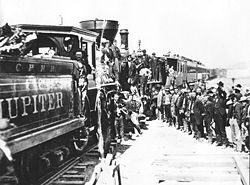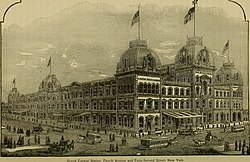Gilded Age
The Gilded Age is a time in the in history of the USA. It lasted from the end of the American Civil War, and up to the late 19th century. It corresponds to the latter part of the British Victorian era.
The name Gilded Age was first used by writer Mark Twain in The Gilded Age: A Tale of Today (1873). The time saw rapid progress in technology and railroad expansions and industrialization.[1] Immigrants came in the millions. The intense political partisanship of the day included disputes over currency, tariffs, political corruption and patronage, railroads and business trusts.[2]
Gilded Age Media
The celebration of the completion of the first transcontinental railroad, May 10, 1869
The Toluca Street Oil Field in Los Angeles oil district, 1900
Grand Central Depot in New York City, opened in 1871
Cornelius Vanderbilt versus James Fisk Jr. in a famous rivalry with the Erie Railroad
The Oswego starch factory in Oswego, New York, 1876
Scottish immigrant Andrew Carnegie led the enormous expansion of the American steel industry.
An octopus representing Standard Oil with tentacles wrapped around Congress and state capitals, as well as the steel, copper, and shipping industries, and reaching for the White House. 1904 cartoon by Udo Keppler.
An 1883 Puck magazine cartoon showing Cyrus Field, Jay Gould, William H. Vanderbilt, and Russell Sage, protected from a sea of "hard times" by an island of personal wealth and low wages that is supported on the backs of workers
References
- ↑ "The Gilded Age". US History. Retrieved 2 November 2015.
- ↑ "Digital History". www.digitalhistory.uh.edu. Retrieved 2018-02-07.










